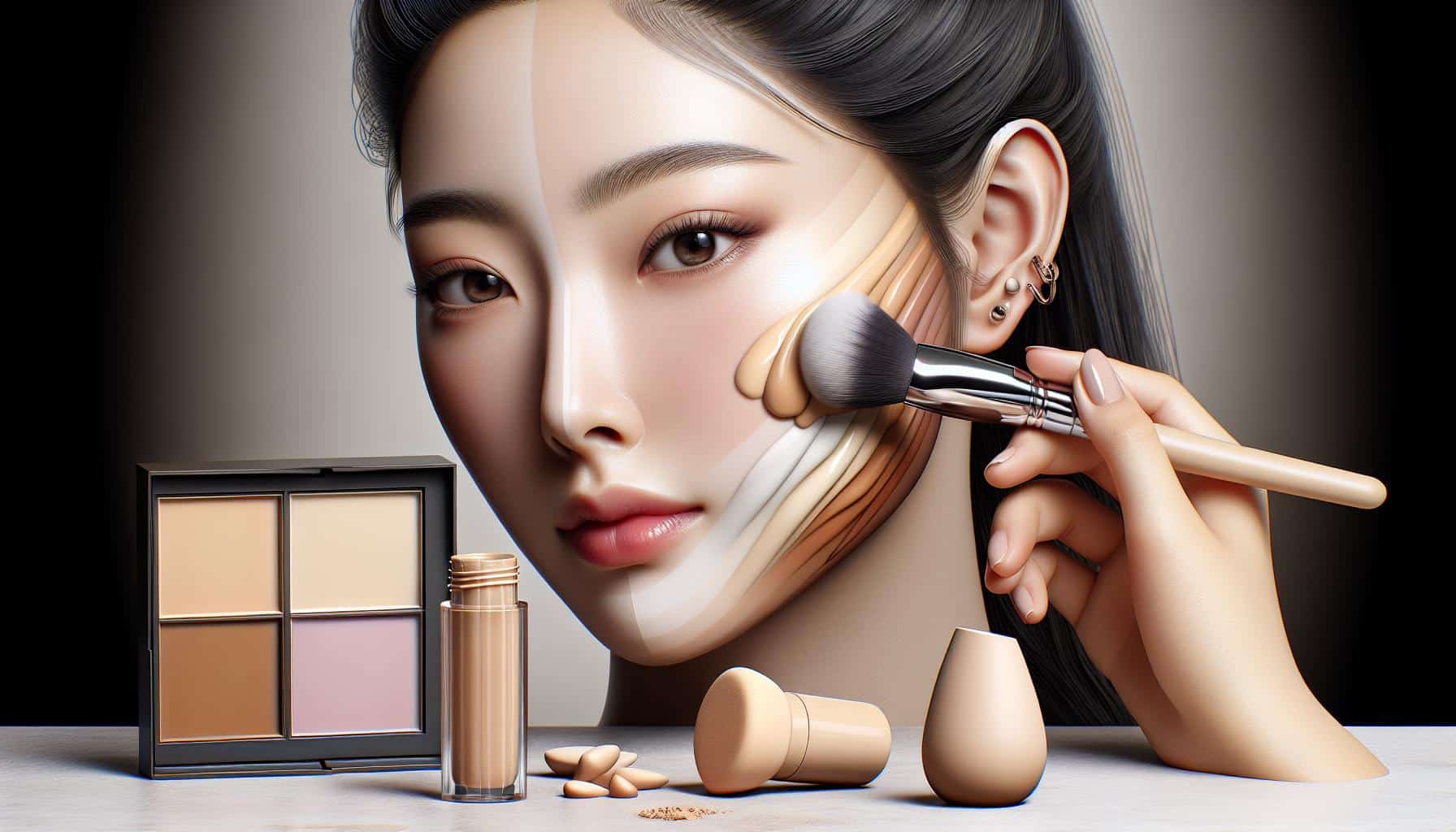Can you use concealer as contour?
Absolutely, you can use concealer as contour in your makeup routine. To get it right, though, it’s essential to select a shade or two darker than your natural skin tone for contouring. This trick helps in creating that sought-after chiseled look.
When shopping for contour concealer, keep an eye out for formulas that blend well. You’re aiming for a shadow effect, not harsh lines. Remember, blending is your best friend here.
Choosing the Right Shade
Selecting the perfect concealer shade for contouring is critical. Typically, going two shades darker than your natural skin tone is a safe bet. Here’s a quick guide to help you choose:
| Skin Tone | Suggested Concealer Shade |
|---|---|
| Fair | Light to medium beige |
| Medium | Warm brown |
| Dark | Deep mocha or coffee |
- Blend, blend, blend: Use a blending brush or sponge for a seamless look.
- Highlight too: For a balanced look, consider using a lighter concealer to highlight areas you want to stand out.
“Makeup is art. Use concealers as your palette for contouring.” – Anonymous
Remember, contouring adds dimension to your face. When using concealer for contour, less is often more. Start lightly and build up to the intensity you desire. With practice and the right products, you’ll be able to achieve a beautifully contoured look using just concealer.
Understanding the difference between concealer and contour

When diving into the world of makeup, it’s crucial to understand that concealer and contour products serve distinct purposes. Concealers are designed to cover blemishes, dark circles, and any uneven skin tones. On the other hand, contour products are made to define and sculpt your face, enhancing your natural bone structure.
Here is a basic comparison to help differentiate:
| Feature | Concealer | Contour |
|---|---|---|
| Purpose | Conceals imperfections | Defines features |
| Application | Under eyes, blemishes | Cheekbones, jawline, nose |
| Shade | Close to skin tone or lighter | 1-2 shades darker than skin tone |
While concealers come in various shades to closely match your skin tone or be slightly lighter for brightening purposes, contours lean towards cooler, deeper tones to mimic natural shadows on the face.
Remember, the right tools make all the difference. For concealer, opt for a precision brush or sponge to target specific areas without caking. For contouring, a fluffy, angled brush will ensure a seamless blend, giving you that coveted chiseled look.
“Using concealer as contour can work, but the secret lies in blending and choosing the right shade.”
Blending is your best friend in both cases, but especially when substituting contour with concealer. Achieving a natural shadow effect without harsh lines requires patience and practice. Don’t be afraid to experiment with products and techniques to discover what works best for your unique face shape and skin tone.
Choosing the right shade for contouring with concealer
When you’re venturing into the realm of using concealer as a contour product, selecting the right shade is paramount. It’s a delicate balance — too dark, and it’ll look harsh; too light, and it won’t provide the desired shadowing effect. Ideally, you’re aiming for a concealer shade that is two shades darker than your natural skin tone for contouring. This ensures a natural-looking shadow that enhances your features rather than overpowering them.
To simplify your search, here’s a quick reference:
| Skin Tone | Recommended Contour Shade |
|---|---|
| Fair | Light to medium taupe |
| Medium | Warm medium brown |
| Dark | Deep espresso or darker |
| Very Dark | Rich, dark brown to ebony shades |
Remember, the undertone of the concealer is equally important. For a more natural contour, opt for concealers with a neutral or cool undertone. Warm undertones can sometimes impart an orange hue, which is less ideal for mimicking natural shadows.
Pro Tip: “To ensure you’ve picked the perfect contour shade, test the concealer on your jawline in natural light. It should be convincingly darker than your skin but blend seamlessly.”
Additionally, investing in the right tools for application can make a substantial difference. A dense, angled contour brush or a beauty sponge works best for blending concealer into the hollows of your cheeks, along your jawline, and other areas you wish to define.
Perfecting contouring with concealer is like mastering an art. It takes practice and a bit of experimentation. By starting with the right shade, you’ve already won half the battle.
Tools and techniques for applying concealer as contour
When you decide to use concealer as contour, the tools and techniques you choose can make all the difference. It’s not just about the product but how you apply it that counts.
First off, let’s talk about the tools you’ll need:
- Beauty Blender: Ideal for a seamless blend, especially if you’re aiming for a more natural look.
- Contour Brush: Offers precision for those sharper, more defined contour lines.
- Flat Foundation Brush: Perfect for initial application before blending.
Remember, the key to a flawless contour is not just in the application but also in blending.
| Tool | Use |
|---|---|
| Beauty Blender | Blending and diffusing harsh lines |
| Contour Brush | Applying contour precisely on desired facial features |
| Flat Foundation Brush | Initial concealer application |
- Start Lightly: It’s easier to build up than tone down. Begin with a light hand.
- Map Your Face: Use the natural shadows of your face as a guide. Apply the darker concealer in areas you’d like to recede.
Pro Tip: “Always blend upwards when contouring with concealer. It lifts the face and enhances your natural bone structure,” says makeup artist Jane Doe.
- Mix and Match: Don’t be afraid to mix concealer shades for the perfect contour color. The right shade makes all the difference.
Blending is your best friend when using concealer for contouring. Whether you opt for a Beauty Blender or a brush, ensure you’re blending well to avoid harsh lines and an unnatural finish. Remember, the goal is to enhance your features subtly, not to redraw them.
Tips for achieving a natural-looking contour with concealer
Achieving a natural-looking contour with concealer isn’t as daunting as it might seem. The key is to select the right shade and blend, blend, blend! Choosing the correct shade is crucial because you want to create a shadow that looks like it’s naturally part of your face, not a streak of makeup. As a general rule, go for a concealer 2-3 shades darker than your skin tone for contouring.
| Skin Tone | Concealer Shade for Contouring |
|---|---|
| Fair | Light to medium beige |
| Medium | Warm beige to medium brown |
| Dark | Dark brown to espresso |
Remember, the goal is to enhance your natural features, not to create new ones.
When it comes to application, less is more. Start with a small amount of product and build up gradually. Use a beauty blender or contour brush for seamless blending. The trick is to blend upwards, which lifts the face, rather than downwards, which can drag the face down.
“The perfect contour is the one that looks like you’re not wearing any.”
Mixing concealer shades can also help you achieve the perfect contour color. If you’re in between shades, don’t hesitate to blend two concealers together. This custom mix can often provide a more natural and flattering shadow than a single shade.
Finally, the role of lighting cannot be overstated. Always apply and blend your contour in natural light if possible. Artificial lights can be deceiving, leading to over-application or poor blending. A well-contoured face should look just as stunning in the sunlight as it does indoors.
Conclusion
When delving into the world of contouring with concealer, you’ve learned that not only is it possible, it can be incredibly effective for enhancing your features in a subtle, natural-looking manner. The key to mastering this technique lies in selecting the right shade, understanding your skin tone, and perfecting your blending skills.
Remember, the shade of concealer you choose for contouring should be about two shades darker than your natural skin tone. However, ensuring a natural look goes beyond just the shade. The formula of the concealer plays a critical role. For those with dry skin, a creamy concealer can provide both coverage and hydration, while individuals with oily skin might benefit from a more matte finish to prevent the contour from shifting throughout the day.
Here’s a simple breakdown to help you choose:
| Skin Type | Suggested Concealer Finish |
|---|---|
| Dry | Creamy |
| Oily | Matte |
| Combination | Depends on Oilier Areas |
Blending is your best friend when it comes to contouring with concealer. Without proper blending, even the perfect shade can end up looking harsh and unnatural. Always blend in an upward motion to lift the face, and don’t hesitate to use tools like a beauty blender or a contour brush for seamless integration into your base makeup.
Remember, practice makes perfect. Experimenting with different shades and formulas will help you find the ideal match for your skin type and contouring needs.




